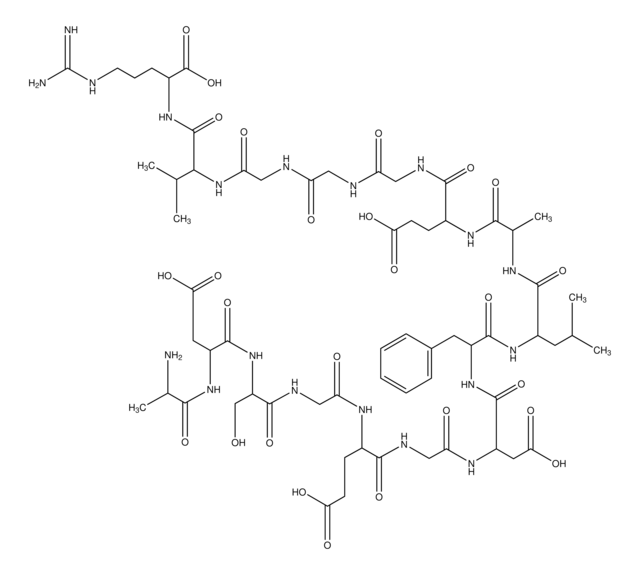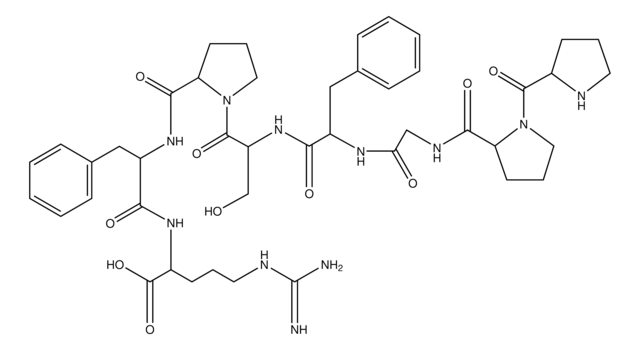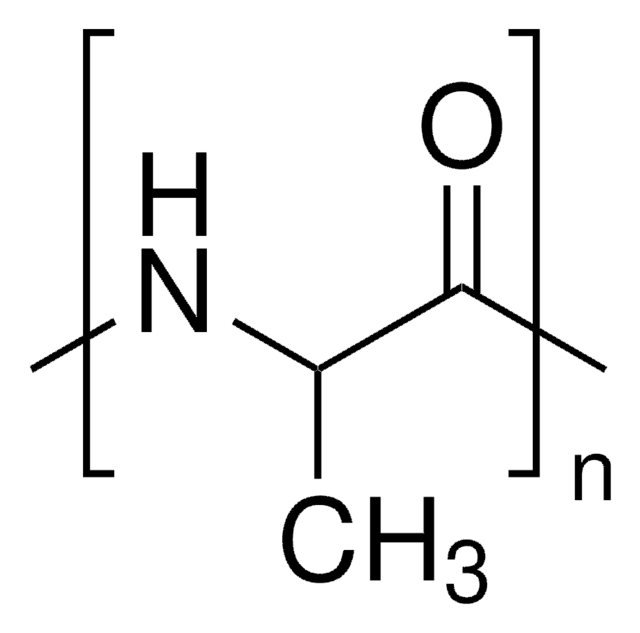F3261
[Glu1]-Fibrinopeptide B human
≥90% (HPLC)
Synonym(s):
Fibrinopeptide B
About This Item
Recommended Products
biological source
human
Quality Level
Assay
≥90% (HPLC)
form
powder
technique(s)
LC/MS: suitable
electrophoresis: suitable
UniProt accession no.
storage temp.
−20°C
SMILES string
CC(C)[C@H](NC(=O)CNC(=O)[C@@H](N)CCC(O)=O)C(=O)N[C@@H](CC(N)=O)C(=O)N[C@@H](CC(O)=O)C(=O)N[C@@H](CC(N)=O)C(=O)N[C@@H](CCC(O)=O)C(=O)N[C@@H](CCC(O)=O)C(=O)NCC(=O)N[C@@H](Cc1ccccc1)C(=O)N[C@@H](Cc2ccccc2)C(=O)N[C@@H](CO)C(=O)N[C@@H](C)C(=O)N[C@@H](CCCNC(N)=N)C(O)=O
InChI
1S/C66H95N19O26/c1-31(2)53(85-48(90)29-73-55(100)35(67)16-19-49(91)92)64(109)83-42(26-46(69)88)61(106)82-43(27-52(97)98)62(107)81-41(25-45(68)87)60(105)78-37(18-21-51(95)96)57(102)77-36(17-20-50(93)94)56(101)74-28-47(89)76-39(23-33-11-6-4-7-12-33)58(103)80-40(24-34-13-8-5-9-14-34)59(104)84-44(30-86)63(108)75-32(3)54(99)79-38(65(110)111)15-10-22-72-66(70)71/h4-9,11-14,31-32,35-44,53,86H,10,15-30,67H2,1-3H3,(H2,68,87)(H2,69,88)(H,73,100)(H,74,101)(H,75,108)(H,76,89)(H,77,102)(H,78,105)(H,79,99)(H,80,103)(H,81,107)(H,82,106)(H,83,109)(H,84,104)(H,85,90)(H,91,92)(H,93,94)(H,95,96)(H,97,98)(H,110,111)(H4,70,71,72)/t32-,35-,36-,37-,38-,39-,40-,41-,42-,43-,44-,53-/m0/s1
InChI key
KPBJTGOVJLITON-OECXYHNASA-N
Gene Information
human ... FGB(2244)
Looking for similar products? Visit Product Comparison Guide
Amino Acid Sequence
General description
Application
- during LC-MS to avoid cross-contamination and to analyze the performance of mass spectrometer and LC-instrument
- for two-point calibration during 2D (dimensional) gel electrophoresis and protein identification by mass spectrometry of histidine (his)-Pup (prokaryotic ubiquitin-like protein) isolated from Mycobacterium smegmatis
- for two-point calibration during one-dimensional gel electrophoresis and tandem mass spectrometry (MS) for the characterization of soluble protein sample obtained from the salivary gland homogenates of Cimex lectularius
- as a standard for the correction of mass drift in data obtained from MS and MS/MS performed on peptides obtained from trypsin-digestion of protein disulfide isomerase (PDI)
Biochem/physiol Actions
Other Notes
Storage Class Code
11 - Combustible Solids
WGK
WGK 3
Flash Point(F)
Not applicable
Flash Point(C)
Not applicable
Personal Protective Equipment
Certificates of Analysis (COA)
Search for Certificates of Analysis (COA) by entering the products Lot/Batch Number. Lot and Batch Numbers can be found on a product’s label following the words ‘Lot’ or ‘Batch’.
Already Own This Product?
Find documentation for the products that you have recently purchased in the Document Library.
Customers Also Viewed
Our team of scientists has experience in all areas of research including Life Science, Material Science, Chemical Synthesis, Chromatography, Analytical and many others.
Contact Technical Service










![[Met5]Enkephalin acetate salt hydrate ≥95.0% (HPLC), powder](/deepweb/assets/sigmaaldrich/product/structures/158/699/80b4b65b-7e48-49a2-ba61-4433cf1f375c/640/80b4b65b-7e48-49a2-ba61-4433cf1f375c.png)

